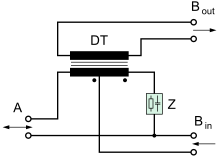Differential transformer
A differential transformer , within the measurement paths as English linear variable differential transformer , abbreviated as LVDT referred to, is a special form of a transformer . It usually consists of a primary coil and two secondary coils. The latter are connected in series out of phase, so the voltages at their connections are subtracted. The resulting voltage is zero if the two coils and the entire construction are symmetrical. If the symmetry is disturbed, an output voltage is created whose phase in relation to the excitation (primary voltage) indicates the direction and whose value indicates the size of the asymmetry.
Distance measurement
An important application of this principle is distance measurement using the linearly variable differential transformer (LVDT). Two secondary coils ( B in the sketch) are attached symmetrically on both sides of a central excitation coil ( A in the sketch) . An alternating voltage with constant amplitude and constant frequency is applied to the primary coil , which as a rule has a frequency of 1 to 10 kHz.
A mechanically movable soft iron core , shown in blue in the sketch, changes the coupling factors between the coils. If it is in the middle position, the arrangement is symmetrical, the voltage from the secondary coils is canceled and there is no output signal. If it is moved, there is an unequal magnetic coupling and this creates an output voltage on the secondary coils. A directional signal can be generated through a correlation with the excitation voltage.
The linear measuring range is between ± 1 mm and ± 500 mm. Dial indicators that work according to this principle usually have a measuring accuracy of less than 1 micrometer .
RVDT
A variant of the LVDT is the Rotary Variable Differential Transformer (RVDT) or resolver . This works on the same principle, but does not measure the distance, but the angle of rotation of the soft iron core.
Signal transmission
Hybrid circuit
The used among other things in phones hybrid allows using a differential transformer simultaneous use one line for both signal directions (the phone listening and speaking) without one of the signals passes to the other. For this purpose, the transmission line is connected to one end of the double winding of the transformer, and a simulation of the same impedance Z to the other . The transmitted useful signal is fed into the connection point and enters the line and the replica in phase. The useful signal received is induced into the transformer via the third winding and is conducted and simulated in antiphase. Both signals do not influence each other if the simulation and the line as well as the two transformer part-windings are symmetrical to each other.
Common-mode chokes ( common mode choke )
Differential transformers with only two coils are used to capacitively and inductively suppress common-mode interference that reaches power supply and signal lines (see common-mode rejection ). They are here common mode choke. common mode choke , called, see choke . If, for example, a double line is parallel to a power line, interference voltages and interference currents present on it are capacitively and inductively coupled into the signal line. However, since the two wires of the line are close to each other and are mostly twisted together, the same interference voltage with the same phase position reaches both wires.
If a winding of a double choke is connected in series with both lines, the antiphase currents of the line (i.e. the signal or the mains voltage) experience only a low resistance, as their magnetic fields cancel each other out in the double choke. For the interference currents, however, the two coils have an inductive resistance Z of
- ,
where L is the inductance of one of the two sub-coils.
On the other hand, the symmetrical (i.e. in phase opposition on both wires) useful voltage is not influenced - it is zero due to the same winding direction of the two coils and their close inductive coupling to them.
High frequency technology
The interference suppression can be increased in the case of a single interference frequency if the turns of the coils are converted into blocking circuits for the interference voltage by connecting capacitors in parallel. Such arrangements are used, for example, in radio technology for feeding antennas, where there is a risk that high-frequency energy can flow away via the feed lines.
A similar arrangement is also used to transport auxiliary voltages to systems that are subject to high-frequency high voltage (for example isolated self-radiating transmission masts ). Here, the cable is laid inside the tube of a coil made of tube of a blocking circuit for the transmission frequency. The transmission high frequency is induced in phase on all wires of the cable and is just as high as on the trap circuit. One end of this is at ground potential so that the signal line there is free of high frequency.
Individual evidence
- ↑ Measuring Position and Displacement with LVDTs. Retrieved January 10, 2011 .




